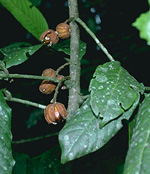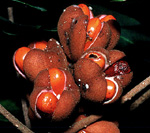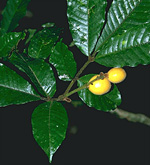 |
This is a moderate-sized family found in tropical and subtropical areas throughout the world. In Australia it is a family of trees and large shrubs often occuring as minor understorey trees in rainforests and warm, moist eucalypt forests from southern New South Wales around the coast to the Kimberleys. A few species of Owenia extend into the arid region.
Characteristic features of the family Meliaceae in Australia include: - trees or shrubs often with an onion-like smell to freshly cut bark
- leaves alternate, pinnately compound or simple, sometimes with oil-dots, often with domatia (pits, pockets or hair-tufts in the vein angles) on the undersurface
- flowers regular, whitish or greenish, with free petals and stamens usually united in a distinct tube around the style, with anthers borne sessile or on short filaments at the apex of the tube
- ovary superior, maturing into a capsule, berry or drupe, sometimes winged
Description
Evergreen or semi-deciduous trees, rarely shrubs. Internal secretions not obvious or rarely of milky sap (latex) or resin. Plants glabrous, or with simple or rarely dendritic or stellate, non-glandular, unicellular hairs, or peltate scales. Leaves alternate and spiral, or rarely opposite, whorled or pseudo-whorled, petiolate. Stipules and stipellae absent. Lamina once compound, rarely simple or bicompound, paripinnate or imparipinnate, rarely ternate, symmetric or conspicuously asymmetric; leaflets/lamina lanceolate, ovate, elliptic, oblanceolate or obovate; base cuneate, attenuate, oblique, or rarely cordate; margins entire or dentate, rarely serrate, ±flat; venation pinnate, with the midrib conspicuous or inconspicuous, and the tertiary venation reticulate or not; surfaces not punctate; herbaceous or leathery; distinctive odour absent or rarely aromatic. Domatia rarely present, consisting of pits, pockets or hair tufts in the vein angles. Male and female flowers occurring on the same plant or on separate plants, or with all the flowers bisexual. Inflorescences axillary, terminal, cauliflorous or rarely ramiflorous, consisting of spikes, racemes, panicles, cymes or thyrses. Bracts present. Bracteoles rarely absent. Pollination by insects. Flowers odourless or fragrant or malodorous, sessile or stalked. Floral disc present or absent; nectaries absent or present on the disc. Free hypanthium present or absent. Perianth of 2 dissimilar whorls, imbricate or valvate in bud. Calyx regular; segments free or fused, with 3–5 sepals or lobes; calyx cup-shaped, herbaceous. Corolla regular or rarely irregular; segments free or fused, with 3–5 petals or lobes, alternating with the calyx segments; corolla wheel-shaped, cup-shaped or tubular, rarely curved-tubular, white, cream, yellow, pink or green, without contrasting markings, membranous; claws absent; lobes ±entire. Fertile stamens (3–) 5, opposite to the sepals or calyx lobes. Staminal filaments present, usually united into an open or closed tube, rarely free or partly fused to the perianth, ovary or style; all ±equal, or clearly alternating long and short. Anthers dorsifixed or basifixed, not versatile, opening inwards by longitudinal slits, 2-celled; appendages absent or rarely apical. Ovary superior and sessile. Carpels 2–5, fused; ovary with 2–5 locules. Style terminal, single and unbranched with the stigma truncate, capitate or peltate. Ovules 1–10 per locule, stalked or rarely sessile; placentation parietal. Fruit a dry dehiscent or septicidal or loculicidal capsule, or a fleshy indehiscent berry, or a drupe; the perianth on the maturing fruit deciduous. Disseminule macro-surface featureless or winged; micro-surface ±smooth, orange, pink, magenta, purple, violet, brown or black, without contrasting markings, or conspicuously patterned, glossy or dull. Seeds 1–50 per fruit. Aril present or absent. Cotyledons 2. Embryo straight.
(Note: this description has been generated from the coded data compiled for the key. Any errors in the key data will be reflected in the descriptions.)
A treatment of the family Meliaceae has not yet been published in the
Flora of Australia. It will appear in Volume 26.
Australian genera of Meliaceae (as recognised for the Flora of Australia)
Aglaia
Anthocarapa
Chisocheton
Dysoxylum
Melia
Owenia
Synoum
Toona
Turraea
Vavaea
Xylocarpus

|
  |

Aglaia australiensis (fruits)
Photo: H.Nicholson © H. & N. Nicholson

Aglaia meridionalis (Amoora ferruginea) (fruits)
Photo: G.Sankowski © Zodiac Publications

Aglaia sapindina (flowers)
Photo: H.Nicholson © H. & N. Nicholson

Aglaia tomentosa (fruits)
Photo: H.Nicholson © H. & N. Nicholson

|
 |
|